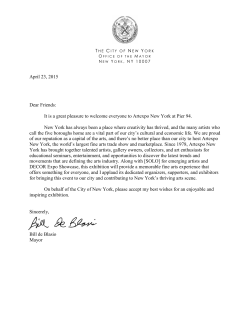
The State of Things: Roger White`s âThe Contemporaries - Exhibit-e
The State of Things: Roger White’s “The Contemporaries” Paints a Clear Picture of the Art World Today BY MOSTAFA HEDDAYA | MARCH 19, 2015 Roger White and the cover of his new book, "The Contemporaries." (Photo by Maggie Clinton, Courtesy Bloomsbury The perambulatory, socio-anthropological genre of art writing receives a much-needed invigoration in Roger White’s “The Contemporaries: Travels in the 21st-Century Art World,” out earlier this month from Bloomsbury. Moving nimbly from the macro concerns of academy, studio, and marketplace to intimate engagements with three artists, the titular “contemporaries” — Dana Schutz, Mary Walling Blackburn, Stephen Kaltenbach — White’s essayistic reporting is even-keeled and lucid while maintaining an energetic curiosity. The insider gloss typically peddled by the contemporary-art-for-laypeople genre is here traded for methodical explanations of studio practice and the mythos of the artist — from the Factory to the Koons factory, macho modernism to MFAs to the “Milwaukee model.” As the author puts it himself, he is not interested in the “professionalized and financialized” facade of the art world but the “profound tensions” undergirding it. Crucially, the art-school apparatus is brought in for much-needed demystification here, and White offers nuanced prose on the credentialing juggernaut that’s as maligned as it is misunderstood. Though a virulent, student-debt oriented pushback has (rightly) greeted the art institution in recent years, with the proliferation of free and non-accredited peer-driven alternatives, White reminds us that “more artists now come through art programs in the United States each year than were produced by the city-states of Florence and Venice during the entire fifteenth century.” The terrain of the contemporary academy is expertly dissected here, with White layering context and analysis on a first-person account of a “crit” at the Rhode Island School of Design, where he teaches. The scenes are richly reported: no detail, from apparel to elocution, is spared. White weighs in with memorably-formulated critical asides, describing in one parenthetical, for example, the transition of the art instructor “from silent and inscrutable icon to something more like a full-time life coach.” In many ways the book’s first chapter is its strongest, offering up a sensitive look at the academy, the “uchronia, not utopia” of MFA-space as a micro — or is it macro? — cosm for the ideas and social relations constitutive of art-making. It’s an area familiar to the author, who teaches and holds an MFA from Columbia — credentials that no doubt add a dimension of self-interest to the discussion, but the reader is spared the usual crudely polemical take all the same. (This component of the book is also a much-needed update to “Art Subjects,” the definitive 1999 study of the MFA scene by the academic Howard Singerman.) But those coming to “The Contemporaries” in search of juicy “insider” anecdotes will also find their fix, particularly in the second chapter on artist assistantships, which delivers Page Six-strength gossip (one blind item tells of a Christmas gift in the form of an offer from employer to assistant to sign a painting of the assistant’s own initiative, thus transmuting her volunteer labor into five-figure value) alongside more substantive ruminations about the changing face of the art profession’s entry-level (and, in the third chapter, its broader spectrum and possibilities). The second half of the book is given away to three in-depth reports on three divergent artists: the figurative painter Dana Schutz, whose commercial career took off even as art academia seemed to have all but moved on from her interests, and two generationally distant yet equally mercurial, difficult-to-pin-down practitioners: Mary Walling Blackburn and Stephen Kaltenbach. Situated somewhere between magazine profile and critical essay, the engagement with and selection of these artists is both illuminating and unorthodox — only Schutz is in any way a boldface name in contemporary art. But these choices in style and substance vindicate White’s method and project: that “contemporary art” is not so much a beachhead as it is a dense and variegated terrain, of which this book is a worthy (and entertaining) cross-section.
© Copyright 2025













